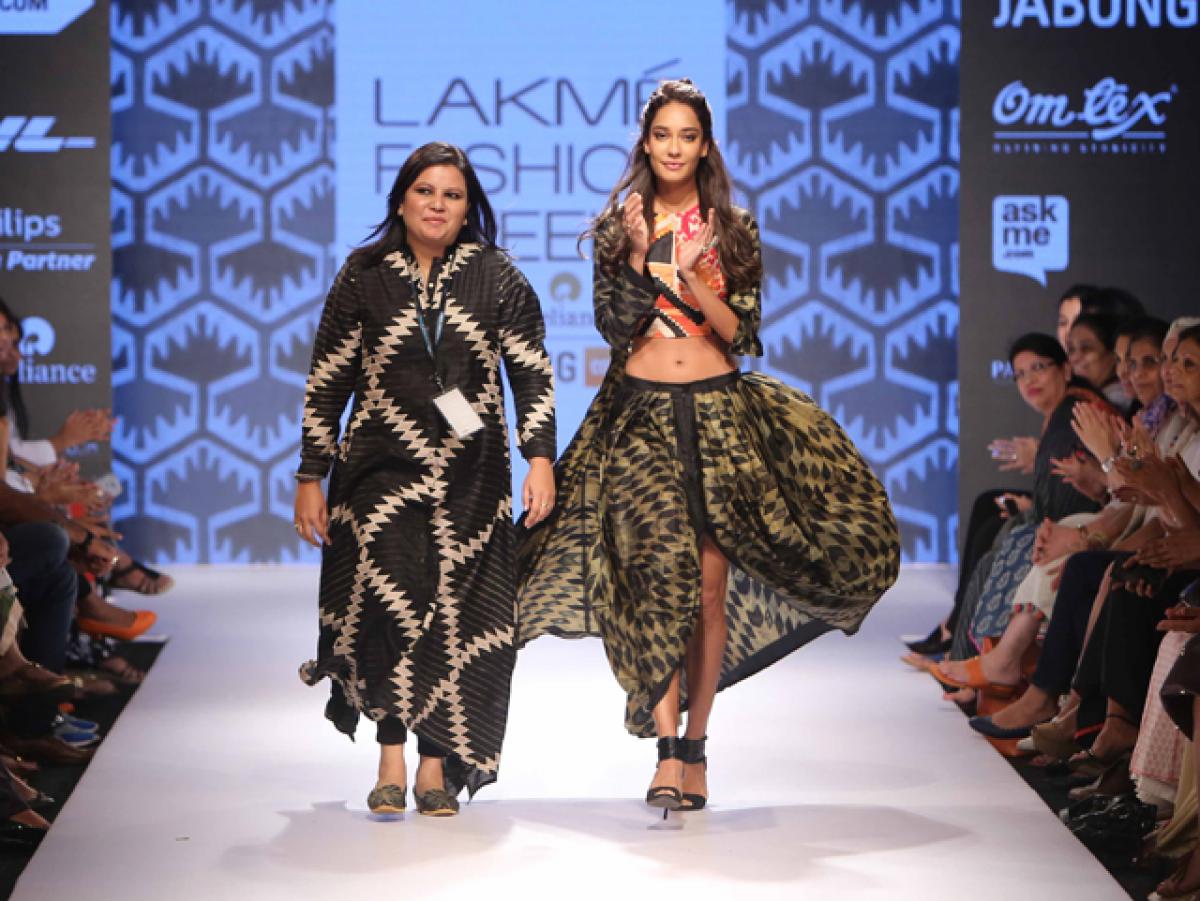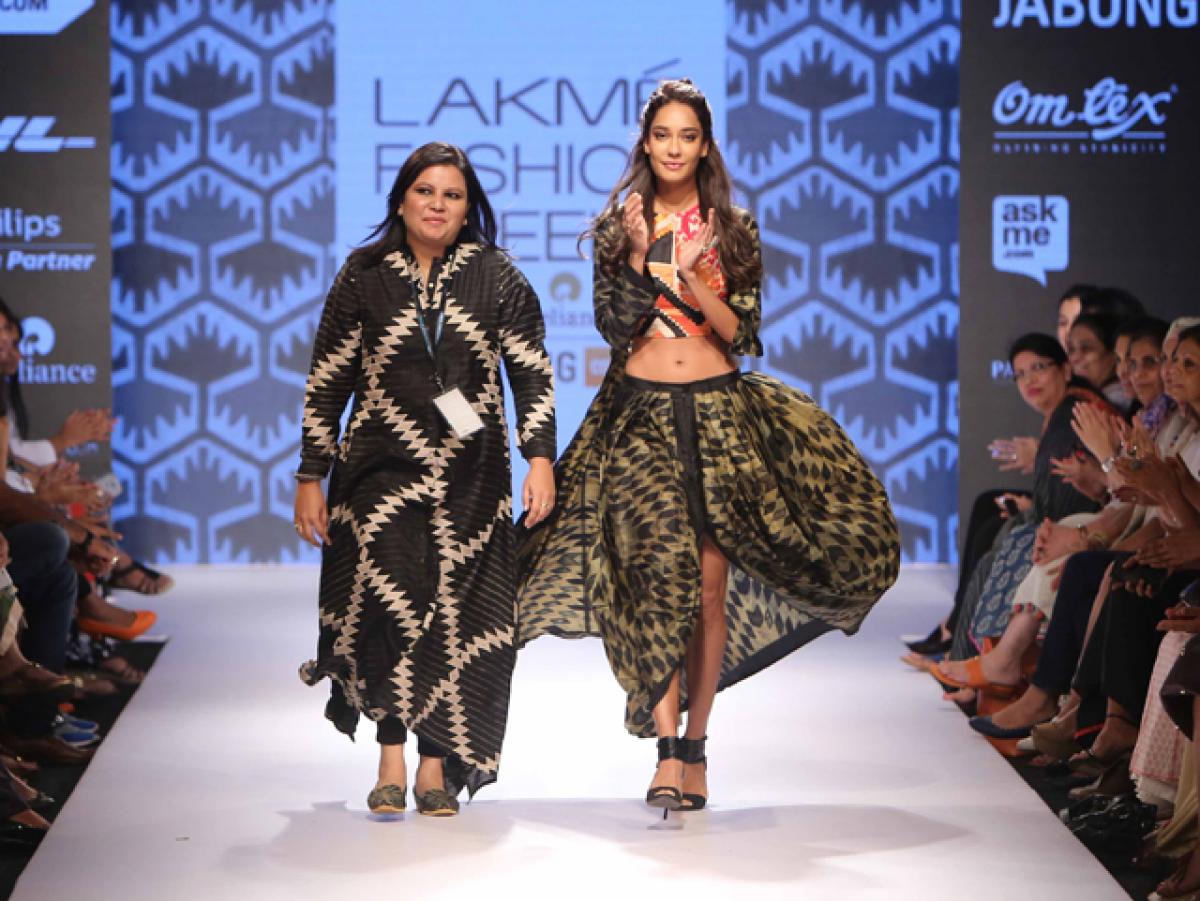Live
- BJP MP candidate Bharat Prasad visited the student who tried to commit suicide
- PM’s popularity in the fast lane: Autos with 'Har Dil Mein Modi' slogan spotted across Delhi
- Delhi-based political parties are like East India Company: Sukhbir Badal
- Golf: Diksha moves into Top-20 at South African Women’s Open
- KCR lashes out against BJP and Congress for destroying Telangana
- Dairy Science students visited the Milk cooling plant
- Moody feels Pant ahead in keepers’ race for T20 WC squad; Srikkanth picks Rahul over Samson as reserve keeper
- Thanking voters for extending 'unparalleled support' to NDA, PM Modi says second phase 'too good'
- Natural Relief for Menstrual Cramps: Beetroot Juice Recipe
- Asha Worker died in a road accident
Just In

Reviving the charm of traditional weaves. Eximious designer Divya Sheth created a fashion stir with a culture-rich collection titled ‘Kalam Putli’ at Lakmé Fashion Week Winter/Festive 2015.
Eximious designer Divya Sheth created a fashion stir with a culture-rich collection titled ‘Kalam Putli’ at Lakmé Fashion Week Winter/Festive 2015. Drawing inspiration from the age old tradition of marionettes from the state of Rajasthan, the range of clothing was elegantly ornate as silhouettes of Indian Rajasthani puppets danced merrily on the garments.
.jpg)
The ever famous art form of Kalamkari was elegantly etched across hand spun, hand-woven Khadi and organic silk, olden Peshwaz and Angias that were contrasted with cotton jersey to give it a present – day look. The hand-woven fabric was meticulously treated and hand painted in natural dyes by skilful artisans.

The accuracy of hand painting made one believe it to be digital prints. The colour palette included hues like black, muted pinks and shades of blue. To add a glimmer to the ensembles, real silver Gotta and Dabka embroidery was incorporated onto the garments adding to the cultural charm.
Two accoutrements that highlighted the show were a two-tone flowing tunic in black and print along with a blue drop-waist flared maxi dress. Ethnic and royal, ‘Kalam Putli’ by Divya Sheth was magnificent and definitely the collection for the fashion diva that is a modern woman who is deeply rooted in tradition.
Swati Vijaivargie’s culture rich parade
Ace couturier Swati Vijaivargie fashioned her collection ‘Mauj’, making the best of waste at Lakmé Fashion Week Winter/Festive 2015. The designer was immensely inspired by the distinctive artistry of flat weaving called Kilim and Dhurrie and also by the artisans who created them. The type of weaving showcased was mainly recognized to be from the states of Rajasthan, Gujarat and Uttar Pradesh.
Clever and creative placements of the detailing on the ensembles added to the appeal of the designs. The basic outlines of the apparels were influenced by the clothes worn by handicraftsmen, especially the dhoti and turbans, which were translated in shades of beige, ecru, burgundy, maroon , emerald green, Persian blue and black.
Motifs were sewn on through appliqué, patchwork and Shibori on fabrics like pure hand woven silks, silk organza, Chanderi, khadi and Kota doriya. Actress and ace model, Lisa Haydon graced the stage with a nude coloured cropped top detailed with colourful embroidered motifs paired with a front open, artfully draped skirt with a long kurta jacket. ‘Mauj’ by Swati Vijaivargie was an ode to the bohemian globetrotter, who would take on the world, one fashion statement at a time.
Old world charm of traditional textiles
Jaipur based designers Rahul and Shikha with their brand ‘Vrisa’ did what they do best and rejuvenated one of the oldest forms of textile designing for their collection ‘A-Jharat’ (derived from Azrak meaning blue in Arabic) at Lakmé Fashion Week Winter/Festive 2015. The clothing line ‘A-jharat’ was based on the Sanskrit word of the same, which was where the fabric was believed to have gotten its name.
The range of clothing was immensely influenced by Ajrak designs and the printing technique used to make unique textiles called Bagru-Dabu. The chroma of the collection had steel blues and tinges of red, white and navy blue peeking through the embroidery.
The silhouettes stayed true to tradition with long anarkalis and kurtas with pleat variations along with colourful tassels and silver detailing. Staying true to their brand ‘Vrisa’, Rahul and Shikha conceptualised ‘A-Jharat’ and the need for “green” clothing that also incorporated art that the nation is famous for, making the wearer a proud fashionista.

© 2024 Hyderabad Media House Limited/The Hans India. All rights reserved. Powered by hocalwire.com







